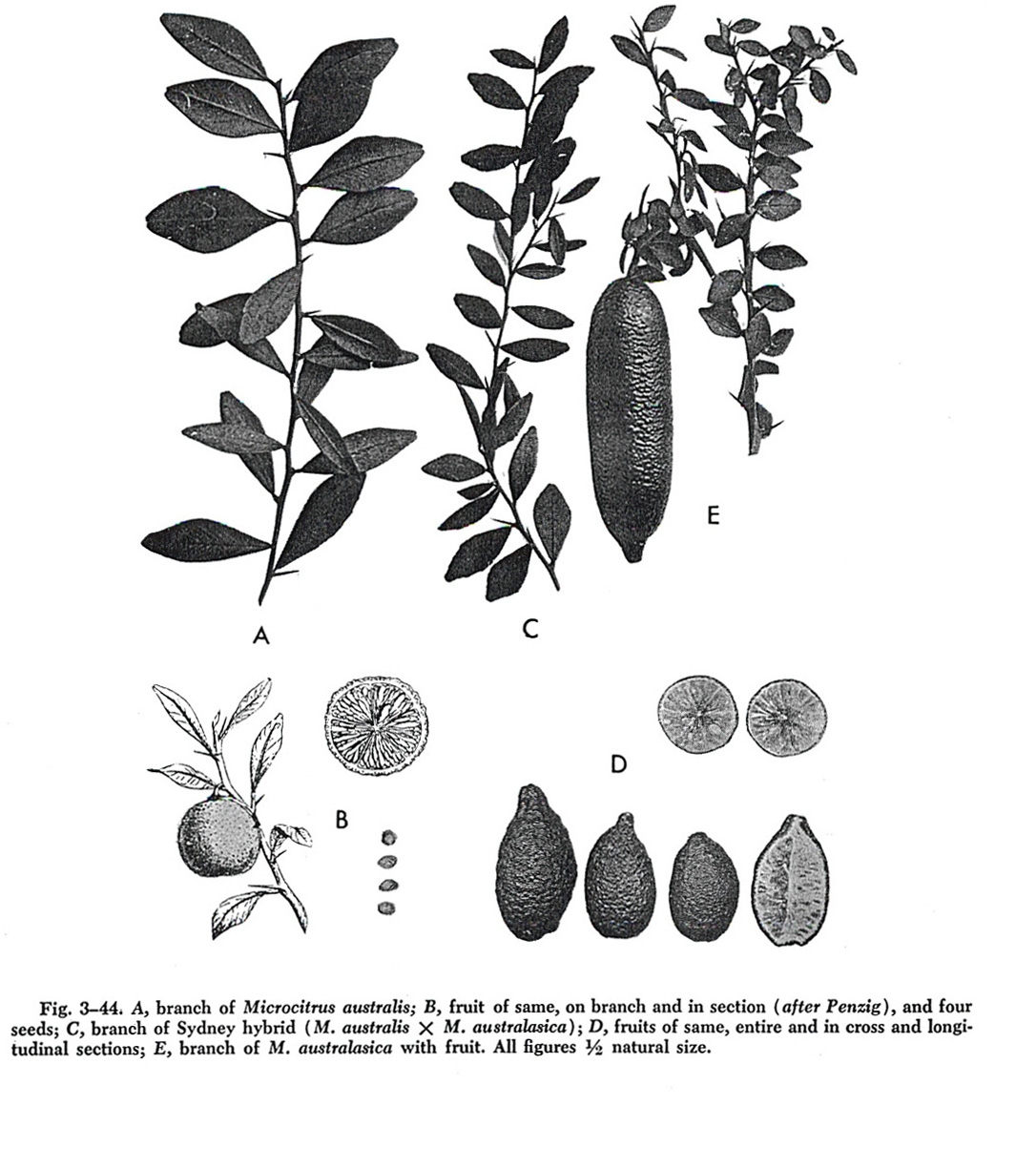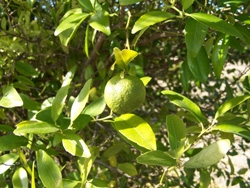|
|||||||||
Select any of 50 available languages! |
|||||||||
Native Australian and New Guinean citrus
|
Botanical classification of Oceanian citrus varieties
History
Distribution Uses Australian finger lime Citrus australasica Cultivated finger lime varieties Wild Fingerlime's Citrus Caviar varieties Faustrime Australian Sunrise Lime Red finger lime Citrus australasica var. sanguinea Australian Blood Lime Australian Round lime Citrus australis Sydney hybrid Citrus × virgata Mount White lime Citrus garrawayae Russel River lime Citrus inodora Maiden's Australian wild lime Citrus maideniana Humpty Doo lime Citrus gracilis Australian desert lime Citrus glauca Australian Outback lime Eremolemon Brown River finger lime Citrus wintersii New Guinea wild lime Citrus warburgiana |
|
| © Gene Lester |
Botanical classification of Native Australian citrus types
| W.T.
Swingle (1871 - 1952) assigned
these citrus types to the genera Microcitrus
and Eremocitrus
based on
several characteristics that in his mind botanically separated them
from the genus
Citrus. These
are listed in his work "The
Botany of Citrus", in Microcitrus
and Eremocitrus.
Swingle was familiar with the work of both F.M. Mueller (1825
- 1896),
Government Botanist of Victoria and F.M. Bailey (1827-1915), Colonial
Botanist of Queensland. Both botanists active in Australia originally
included
these types
in the genus Citrus. Well-known botanists of our time continue this tradition, D.J. Mabberley (b.1948), since 2005 president of IATP, perhaps the most notable among them. A 1998 paper of his Australian Citrae with notes on other Aurantioideae discusses the issue of Australian native citrus classification. However, the re-application of the genus Citrus is not an attempt to raise the status of the native Australian Citrus types but an automatic consequence of the Tokyo Code of 1994, which stipulates that after 1994 the oldest correct classification of a plant is the valid one. In this presentation, the genus Citrus is used followed by the synonyms Microcitrus and Eremocitrus as well as several other historical classifications. |
   |
The citrus types previously known as Microcitrus
The citrus types previously known as Eremocitrus
| This group contains one species, Citrus glauca, known commonly as the Australian desert lime and its cultivar Outback lime and hybrid Eremolemon. The typical form of this type as it occurs in southeastern Queensland is a small tree or a large shrub, sometimes only a few feet in height. It is the only plant in the whole orange subfamily that is able to survive extreme drought. Its hybrids also include eremoranges, eremoradias (a hybrid with the sour orange) and citrangeremos (a hybrid with citrange). |   |
| LAT | Citrus australasica F.Muell. |     Various cultivars |
| Syn | Microcitrus australasica (F.Muell.) Swingle |
|
|
Australian finger lime, (Microcitrus australasica), occurs as an understorey shrub or tree in rainforests in southern Queensland and northern New South Wales. It produces finger-shaped fruit, up to 10cm long, with thin green or yellow skin and greenish-yellow compressed juice vesicles that tend to burst out when the skin is cut. A pink to red-fleshed form with red to purple or even black skin (known as Citrus australasica var. sanguinea) also occurs in the wild. Fruits are cylindric, 1.5 - 2.5 cm long, often slightly curved, narrowed at both tip and base. Peel rough with numerous oil glands, greenish-yellow at maturity; pulp-vesicles nearly free or loosely cohering, seeds numerous, small, 6-7 mm long, ovoid, usually flattened on one side. The first leaves are minute linear cataphylls; these gradually merge into juvenile foliage which, in turn, merges into the mature foliage, the leaves of which are smaller than those of any other True Citrus Fruit Tree with the exception of Citrus glauca, when the latter occurs in very dry situations. There numerous selected varieties available for growers. See next entry. Various producers have their own specialties. See Wild Fingerlime below. |
||
| ENG | Finger lime, Australian finger lime | |
| FRA | Lime digitée d'Australie | |
| Photos | © Gene Lester | |
| Link | ||
| LAT | Citrus australasica F.Muell. Cultivated varieties |        |
| Syn |
Microcitrus australasica (F.Muell.) Swingle |
|
|
The Australian Cultivar Registration Authority Inc. (ACRA) has registered following cultivated varieties of the Australian Finger Lime. 'Alstonville' Originated at Alstonville on the far north coast of NSW and was selected in 1989. A moderately dense tall shrub or small tree to a maximum of 3-4 metres high by 2 metres wide. Axillary spines solitary, straight to 25mm long. Leaves are simple, obovate to elliptic, glabrous. Flowers white (with pink buds) approximately 10-15mm in diameter. Fruit a cylindrical berry, 4-8 cms long, 15-25mm in diameter from August to September (AUS), dark green to black, vescicles translucent pale green. ‘Alstonville’ is a tall growing selection which bears fruit earlier and in large clusters with few to no seeds. Accepted for registration 1 February 2007. 'Blunobia Pink Crystal' A dense medium shrub 2 metres high by 1 metres wide. Axillary spines solitary, straight to 25mm long. Leaves are small and narrow, simple, obovate to elliptic, glabrous, new foliage light green in colour. Flowers white (with pink buds) approximately 10-15mm in diameter from August to September. Fruit a cylindrical berry, 4-8 cms long, 15-25mm in diameter , skin green with brown overtone, vesicles deep pink and easy to extract. ‘Blunobia’ is the name of farm in Mt Burrell, Murwillumbah where originators Jim and Barbara O’Brien live. Cultivar first introduced in 1988. Accepted for registration 1 February 2007. 'Byron Sunrise' Very narrow upright tall shrub or small tree to a maximum of 2 metres high by 600mm wide. Delicate small rounded leaves. Flowers white (with pink buds) approximately 10-15mm in diameter in October (AUS). Fruit a cylindrical berry, 40-80 mms long, 15-25mm in diameter, mottled green/brown to black when fully ripe with clean smooth skin. Flesh is tangerine/red. The flesh/vescicles becomes darker when exposed to air for several hours ‘Byron Sunrise’ is a medium sized selection with a clean smooth skin and a distinctive tangerine/red coloured flesh. Accepted for registration 30 June 2010. 'Durhams Emerald' Durhams Emerald originated in the Northern rivers district and was introduced into cultivation in 1994. A moderately dense medium shrub 2 metres high by 1.7 metres wide with a moderately open appearance. Axillary spines solitary, straight to 25mm long. Leaves are simple, obovate to elliptic, glabrous. Flowers white (with pink buds) approximately 10-15mm in diameter, Aug-Sept (AUS). Fruit a cylindrical berry, 4-8 cms long, 15-25mm in diameter, with firm black skin and emerald green pulp. ‘Durhams Emerald’ is a heavy bearer during Summer to late Autumn, with continual light cropping all year around. Vesicles easy to extract. Accepted for registration February 2007. 'Jali Red' Jali Red originated at Whian Whian. Tall shrub or small tree to a maximum of 2-3 metres high by 2 – 2.5 metres wide with a sparse open appearance. Axillary spines solitary, straight to 25mm long. Leaves are simple, obovate to elliptic, glabrous. Flowers white approximately 10-15mm in diameter. Flowering period July – August (AUS). Fruit a cylindrical berry, 40-80mms long, 15-25mm in diameter, dark green to brown, flesh/vescicles red/pink, 2-3mm in diameter. The flesh/vescicles becomes darker when exposed to air for several hours. Jali Red is an open shrub with a distinctive red/pink flesh. Accepted for registration 30 June 2010. 'Judy's Everbearing' Originated at Binna Burra on the outskirts of Bangalow, northern NSW and was selected in 1993. Name derives from the first name of the applicant and the fact that the cultivar bears fruit throughout the year with its main crop being between summer and autumn. Tall shrub or small tree to a maximum of 3-4 metres high by 2 – 3 metres wide with dense foliage. Axillary spines solitary, straight to 25mm long. Leaves are simple, obovate to elliptic, glabrous. Flowers white (with pink buds) approximately 10-15mm in diameter. Fruit a cylindrical berry, 4-8 cms long, 15-25mm in diameter. ‘Judy’s Everbearing’ is a tall growing selection which bears fruit all year round. Accepted for registration 1 February 2007. 'Pink Ice' Pink Ice originated at Alstonville on the far north coast of NSW and was selected in 1989. A moderately dense tall shrub or small tree to a maximum of 2.5-3 metres high by1.3 metres wide. Axillary spines solitary, straight to 25mm long. Leaves are simple, obovate to elliptic, glabrous. Flowers white approximately 10-15mm in diameter, from July-September (AUS). Fruit a cylindrical berry, 4-8 cms long, 15-25mm in diameter. Variation of skin colour green to brown & pink, vescicles from clear to different shades of pink. Pink Ice is a medium growing selection which bears fruit with vescicles varying from clear/translucent, to deep pink. Accepted for registration 1 February 2007. 'Rainforest Pearl' Citrus australasica var. sanguinea A small open upright tree producing green fruit tinged with crimson with a pink flesh - see Red Finger lime below. More on Growing Australian Fingerlimes from Industry & Investment NSW 2010 . Several producers sell these varieties with their own trade names. Wild Finger Lime with the tradename Citrus Caviar, see below. Finger Limeing Good Pty Limited with the tradename Limeburst. |
||
| ENG | Australian finger lime, cultivated varieties | |
| FRA | ||
| Photos | Photos by Murray Fagg | |
| LAT | Citrus australasica F.Muell. | 
|
| Syn |
Microcitrus australasica (F.Muell.) Swingle |
|
|
Wild Fingerlime markets finger limes in the subtropics of northern New South Wales, where the finger lime is endemic. Wild Fingerlime has conducted research within the Australian restaurant industry and selected a number of export markets to establish the most desirable cultivars. Wild Fingerlime's Citrus Caviar varieties from top to bottom: Rainforest Ruby 1 Rainforest Garnet 1 Rainforest Jade 1 Rainforest Pearl Rainforest Diamond Rainforest Jade 2 Rainforest Topaz |
||
| ENG | Wild Fingerlime's Citrus Caviar varieties | |
| Photo | Photo provided by Wild Fingerlime | |
| LAT | Faustrime |    |
| Syn | Citrus australasica F.Muell. × [Citrus × floridana (J. Ingram & H. Moore) Mabb. 'Limequat Eustis' ] |
|
Faustrime is a trigeneric hybrid of the Australian fingerlime (Microcitrus australasica) and Limequat Eustis, itself a hybrid of Mexican lime (Citrus aurantiifolia) and Round kumquat (Fortunella japonica). It has genes of three citrus fruit genera: Citrus, Microcitrus and Fortunella. The fruit of Faustrime are similar to Finger lime in shape but much larger in size. Faustrime seems to have inherited several characteristics from the Limequat parent. Unlike the Finger lime Faustrime turns yellow when ripe. The juice vesicles of Faustrime are oval whereas the juice vesicles of the Finger lime are round. Faustrime is juicier than Finger lime and the taste is a cross of Mexican lime and Finger lime. In the kitchen Faustrime can be used instead of lime. Faustrime is also grown as an ornamental plant. Disambiguation: Faustrimedin, see below. |
||
| ENG | Faustrime | |
| Photos | © Laaz | |
| LAT | Citrus × oliveri Mabb. 'Australian Sunrise' |   |
| Syn | Citrus australasica 'Australian Sunrise' Citrus australasica × [(Citrus × microcarpa Bunge) × Citrus reticulata var. austera] Faustrimedin 'Australian Sunrise' |
|
The Australian Sunrise lime is a seedling of a Faustrimedin (originally bred in California in 1911), a hybrid of the Finger lime (Citrus australasica) and the Calamondin (Citrus × microcarpa), itself a hybrid between the Nagami kumquat (Citrus japonica 'Nagami') and the sour mandarin (Citrus sunki). "Australian Sunrise was
identified after the evaluation of 24
seedlings grown from open-pollinated monoembryonic
seeds of the Faustrimedin. Seedlings were field-planted
in 1977 and
monitored for fruit yield and quality characteristics. ‘Australian
Sunrise’ was selected from this family of widely variable
zygotic
seedlings in 1990 when 30 trees were propagated by budding on
to citrus rootstocks for
further evaluation. The cultivar was selected for its consistent high
yield of pyriform-shaped, orange fruits which possessed valuable fruit
processing characteristics."
Source: Sykes, W.R. (2002) Description. Plant Varieties Journal 15(4): 20-21 The parent tree of the Australian Sunrise lime was selected in 1990 at CSIRO Plant Industry. The variety has been grown commercially since 2001 and was so successful it was made available for home gardeners in 2005. Australian Sunrise produces attractive golden-coloured fruit on an upright shrub to small tree, usually 2 to 3 m high and 1.5 to 2.5 m wide. Foliage is dark, glossy-green. The oval leaves are approximately 40 to 45 mm long by 20 to 30 mm wide. The cream-coloured flowers occur in spring to early summer. Fruits ripen in winter, are pearshaped and usually 30 to 45 mm long by 20 to 40 mm wide. Seeds are small and plump. Juice squeezed from the fruit has a sharp, clean flavour and a light ‘floral’ aroma. The fruit may be eaten whole and like a kumquat, have a sharpish flesh and a sweet albedo and skin. They can be used in products such as in cordials, beverages, conserves, puree, pastes, sauces, marmalade, syrups and garnishes. Disambiguation: Faustrime, see above. |
||
| ENG | Australian Sunrise lime | |
| FRA | ||
| Photos | © CSIRO Plant Industry | |
| LAT | Citrus australasica var. sanguinea F.M.Bailey |   |
| Syn | Microcitrus australasica var.sanguinea (Bailey) Swingle |
|
Red finger lime, a pink to red-fleshed form of the Australian finger lime with red to purple or even black skin (known as Citrus australasica var. sanguinea) also occurs in the wild. This variety differs from the species in that the pulp-vesicles at maturity vary from pink to red in colour. The red-pulp finger lime has been observed growing throughout the natural distribution of the finger lime. There are similar "pink" or red varieties of oranges (the so-called blood oranges) and grapefruit, some of which are known to have arisen as budsports. However, the red-pulped variety of the Australian finger-lime is found growing wild and can be propagated from seed; it seems to have originated without the aid of man.An Australian finger lime (C. australasica var. sanguinea) cultivar ‘Rainforest Pearl’ was selected for pink pulp, ease of propagation and ornamental properties as a garden subject, including vigour and openness of form. Trees are usually grafted onto Trifoliata or Troyer Citrange rootstocks, are thorny, and although slow to establish, ultimately produce vigorous upright trees 4 to 6m high. Fruit is harvested in late summer and autumn on the north coast of NSW. The variety is registered with Plant Breeders Rights (PBR). |
||
| ENG | Red finger lime, Red-pulped finger lime, Red-fleshed finger lime | |
| FRA | ||
| Photos |
©
Petr
Broža
© Bernhard Voß |
|
| LAT | Citrus australasica 'Australian Blood Lime' |  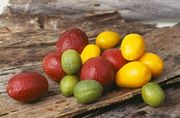 |
| Syn | Citrus australasica var. sanguinea × Citrus limonia 'Rangpur' |
|
Contrary to common belief Australian Blood Lime is not a hybrid of the Red finger lime and the 'Ellendale' mandarin. It is a hybrid where the pollen parent is the said Red finger lime (Citrus australasica var. sanguinea) and seed parent is Rangpur lime (Citrus × limonia 'Rangpur'). See Native Australian Citrus – wild species, cultivars and hybrids published by Primary Industries and Resources, Government of South Australia (PIRSA) FS No: 7/03. The parent tree of the Sunrise Lime was selected in1990 at CSIRO Plant Industry. Under the right conditions the tree produces striking, bloodred coloured fruit, which greatly enhances the appeal of the fresh and processed product. The variety also has potential as an ornamental tree. Fruit is produced on an attractive, dense, upright shrub to small tree, usually 2 to 3 m high and 2 m wide with dark, glossy-green foliage and red growth flushes. Fruits ripen in winter, are oval in shape and are usually 30 to 50 mm long, by 20 to 30 mm wide. The flesh and juice may show red tinges or may occasionally be more intensely red. Seeds are small and plump. The fruit is used in a variety of sweet and savoury dishes and it can be used in many value-added products such as marmalades, preserves, syrups, juices, beverages and sauces. The bottom picture shows Australian 'Blood', 'Outback' and 'Sunrise' limes. |
||
| ENG | Australian Blood lime, Australian Red Centre lime | |
| FRA | ||
| Photos | The bottom picture shows Blood, Outback and Sunrise limes. | © CSIRO Plant Industry |
| LAT | Citrus garrawayae F.M. Bailey |   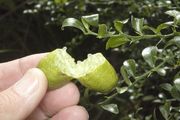 |
| Syn | Microcitrus garrawayae (F.M.Bailey) Swingle |
|
Mount White lime, Citrus garrawayae (previously Microcitrus garrawayae), occurs in rainforests on Cape York Peninsula. It produces a finger-shaped fruit, similar to Finger lime, Citrus australasica, though shorter and thicker, with a pale lemon skin and light green pulp. Due to its limited distribution this species is considered rare in the wild and fruit is not traded commercially. Mount White lime is endemic to the foothills and upland rainforest of the Cook District on Cape York Peninsula. It grows in deciduous vine thickets as an understorey shrub and has been recorded at a height of 15 m. Mount White Lime is similar to Finger lime, but has broader leaves. Fruit forms from April to November. The fruits are also “finger-shaped”, with a green skin and greenish-white pulp on maturity. The fruit can be used for value-added products. |
||
| ENG | Mount White lime, Garraway's Australian wild lime | |
| FRA | ||
| Photos | Photos by Murray Fagg | |
| LAT | Citrus inodora F.M. Bailey | 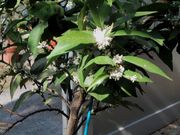   |
| Syn | Microcitrus inodora (F.M.Bailey) Swingle |
|
Russel River lime or Large-leaf Australian wild lime, Citrus inodora (previously Microcitrus inodora), is now rare in the wild. It is native to the high-rainfall lowland rainforest at the foot of the Bellenden-Ker Range between Cairns and Innisfail in northern Queensland, much of which has now been cleared to grow sugar cane or bananas. It is a shrub or small tree 2 to 4 meters high with the trunk 4 to 5 cm in diameter and produces a lemon-shaped fruit. Fruit is not traded commercially. The twigs are angular like those of Citrus sinensis (the sweet orange) and have one or two slender, very sharp spines, 6 to 12 mm long. Leaves are the biggest in the Microcitrus group. As the botanical name suggests there is very little oil both in the leaves and flowers and consequently no odour. The bottom picture is of a fruit 6 mm x 12 mm in size, which Mike Saalfeld managed to grow in the UK. See Home Citrus Growers. |
||
| An
inodora
seedling. Although Australian citrus usually grow true from seed it is not unusual to get hybrids in mixed plantations. In the bottom picture is an inodora plant grown by Gene Lester from seeds he received. The plant itself does not have the typical diamond-shaped leaves even in maturity (10 ft tall) but it does have paired spines, a distinguishing feature of the Russel River lime. Click bottom photo to enlarge. |
 |
|
| ENG | Russel River lime, Large-leaf Australian wild lime, North Queensland lime | |
| FRA | ||
| Photos | © Saga Univ. Dept of
Agriculture (2) © Murray Fagg (3) © Home Citrus Growers (4) © Jorma Koskinen |
|
| (photo 2) Australian National Botanic Gardens | ||
| LAT | Citrus inodora F.M. Bailey var. maideniana | If
you would like to share a picture, please contact Citrus Pages |
| Syn | Microcitrus maideniana (Domin.) Swingle |
|
Commonly known as Maiden’s Australian lime, Swingle's Microcitrus maideniana is often described as a variety or subspecies of the Russel River lime. The two species have a similar distribution, limited to a small area in far North Queensland. The deeply depressed apex of the fruit is the only clearly distinctive character known. Fruit is not commercially traded. Some botanists today consider Russel River lime and Maiden's Australian wild lime to be one and the same species and the name Citrus inodora valid for both. |
||
| ENG | Maiden's Australian wild lime | |
| LAT | Citrus gracilis Mabb. |
  |
| Syn | ||
|
Kakadu lime, Citrus gracilis has recently been described and classified by D.J. Mabberley and grows wild as a straggling tree in eucalypt woodland in the Northern Territory. It has a similar growth habit to Citrus glauca and produces round fruit up to 8cm in diameter.Fruit is not traded commercially. Northern Territory Herbarium lists this as near threatened and endemic to NT. The specific epithet (gracilis) refers to the graceful aspect of the flowering twigs. Superficially resembling Citrus wintersii Mabb. in its narrow leaves, it differs from that New Guinea endemic in not having cylindrical fruits. From the other New Guinea endemic, Microcitrus warburgiana, with which some forms share the broader leaves characteristic of many specimens of that species, it differs in its much larger fruit as it also does from Eremocitrus glauca, which also has narrow leaves and suckering spiny shoots. The pictures were taken by Garry Riggs from Australia. He wrote: "The photo was taken of a tree near Lake Duggan a protected conservation area of 300 hectares on our cattle property west of Mataranka NT. I have never noticed the tree until it started bearing fruit. Then we got interested in identifying the tree. We now have identified a number of Citrus gracilis in the area." For a detailed description see: D.J. Mabberley, Australian Citreae http://www.rbgsyd.nsw.gov.au/__data/assets/pdf_file/0003/73236/Tel7Mab333.pdf |
||
| ENG | Kakadu lime, Humpty Doo lime | |
| FRA | ||
| Photos | © Garry Riggs | |
|
|
||
| LAT | Citrus glauca (Lindlay) Burkill |     |
| Syn | Eremocitrus glauca (Lindlay) Swingle |
|
Australian desert lime is originally from southeastern Queensland. It is able to withstand long periods of severe drought and strong, hot winds. The tree will defoliate, leaving its thin, weeping green branches resembling a smoke tree. It can endure high concentrations of salts in the soil and can grow up to over 7 metres (25 ft) with access to water. Eremocitrus leaves are linear in shape and fruits are green, about the size of a marble, and taste much like a regular lime. It has the shortest flowering to fruit maturity period (about 8 weeks) of any member of the citrus family. Australian desert lime grows wild in Queensland and New South Wales with some isolated occurrences in central South Australia. It is the only known member of the citrus family which is a xerophyte: it is able to withstand severe drought and hot dry winds. Under such conditions the leaves fall off and the leafless gray-green twigs carry on photosynthesis on a reduced scale. The plant tolerates high temperatures (up to 45°C) and when dormant in late winter is able to withstand temperatures below freezing point without injury. Seedlings develop an enormous root system before making vigorous aerial growth and developing full-sized leaves. A new species, Citrus gracilis, has recently been described and grows wild as a straggling tree in Eucalypt woodland in the Northern Territory. It has a similar growth habit to Eremocitrus glauca and produces round fruit up to 8cm in diameter. |
||
| ENG | Australian desert lime, Limebush | |
| FRA | Lime du désert australien | |
| Photos | (1-2) ©
Jorma Koskinen (3-4) © Petr Broža |
|
|
|
||
| LAT | Citrus glauca 'Outback Lime' |  |
| Syn | Eremocitrus glauca 'Outback Lime' |
|
The Australian Outback Lime (also known as ‘Australian Desert’) is a variety of desert lime (Citrus glauca). It is a cultivar selected and developed from a collection of different native desert lime trees, producing small, green, juicy fruits which ripen at Christmas time. The variety was selected in 1990 at CSIRO Plant Industry. It has been grown commercially since 2001 and was so successful it was made available for home gardeners in 2005. Under commercial cultivation it is an open, upright shrub to small tree, usually 2 to 4 m high and 1.5 to 2 m wide. Small, white flowers occur in spring. The crop is carried on the previous season’s growth, towards the outside of the canopy. The flowering to harvest time is extremely short, in the order of 2 to 3 months. The spherical fruits (to 20 mm) have a thin skin and turn from green to yellow as they ripen in early summer. The fruits can be used for preparing sauces. |
||
| ENG | Australian Outback lime | |
| FRA | ||
| Photos | © CSIRO Plant Industry | |
| LAT | Eremolemon |    |
| Syn | Citrus glauca × Citrus meyerii |
|
Eremolemon is believed to be a spontaneous Australian desert lime × Meyer lemon cross that occurred in the Coachella Valley at the U.S. Date & Citrus Station. The leaves are dark green and lanceolate. The fruit is subglobose, yellow and about 20 mm in diameter. It has five or six segments and usually one to three seeds. The seeds seem to be polyembryonic and grow true to type. The trees seem to grow larger than a regular Australian desert lime Citrus glauca but are reported to have the same tolerance for saline soils. Seedlings grow rapidly and have deep taproots. Due to the place of origin the variety is sometimes also called Coachella Eremolemon. |
||
| ENG | Eremolemon | |
| FRA | ||
| Photos | © Gene Lester | |
| LAT | Citrus wintersii Mabb. |
 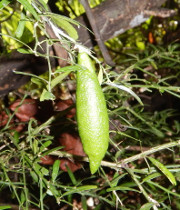 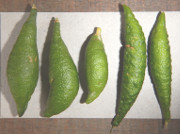  |
| Syn | Microcitrus papuana Winters |
|
| The
new classification of the Brown
River finger lime given by D.J.
Mabberley, Citrus
wintersii, commemorates Harold F. Winters of the USDA,
Beltsville, who first described the plant as recently as 1970.
Finding
information on the two native citrus species not of
Australian origin,
the Brown River finger
lime,
Citrus wintersii (previously Microcitus papuana)
and New Guinea wild lime Citrus warburgiana
(previously Microcitrus warburgiana)
is very difficult. Information on the Brown River
finger lime from Papua New Guinea is very scarce
indeed.
"The plant is a bush that can reach 3 m. The leaves are narrow and about 2-3 cm long. The fusiform fruit has a lenth of 3 to 6 cm. Its color stays green when ripe. Local people say they never become yellow. The vesicules are round, 'caviar' type. The pulp tastes limony." Sylvain Jousse 2014. |
||
Text on the original
herbarium holotype specimen at the
Herbarium of the U.S. National Arboretum dated 26 March 1970 of the new
variety Microcitrus
papuana says: Shrub to 1.5 m; leaves tiny;
slender; spiny twigs; fruit 1.3 cm × 6.35 cm; yellow at
maturity. Wild. |
||
A secondary paratype
shows larger twigs. Both herbarium specimens of Citrus wintersii published with permission of the US National Arboretum, |
||
| ENG | Brown River finger lime, Papuan wild lime | |
| FRA | Lime digité de Brown River | |
| Photos | © Sylvain Jousse | |
|
|
||

|
|
Page up-dated 27 april 2016
Back to top of page








